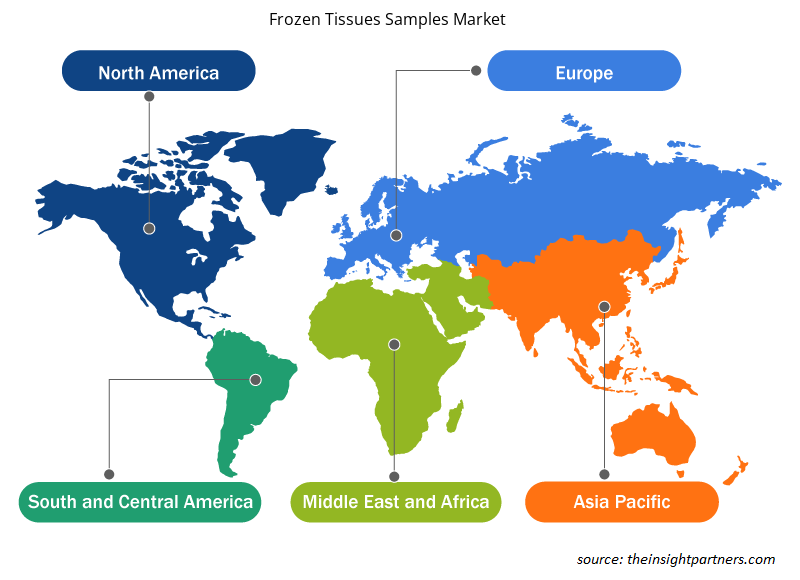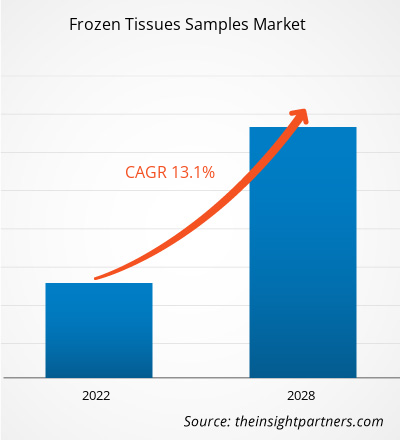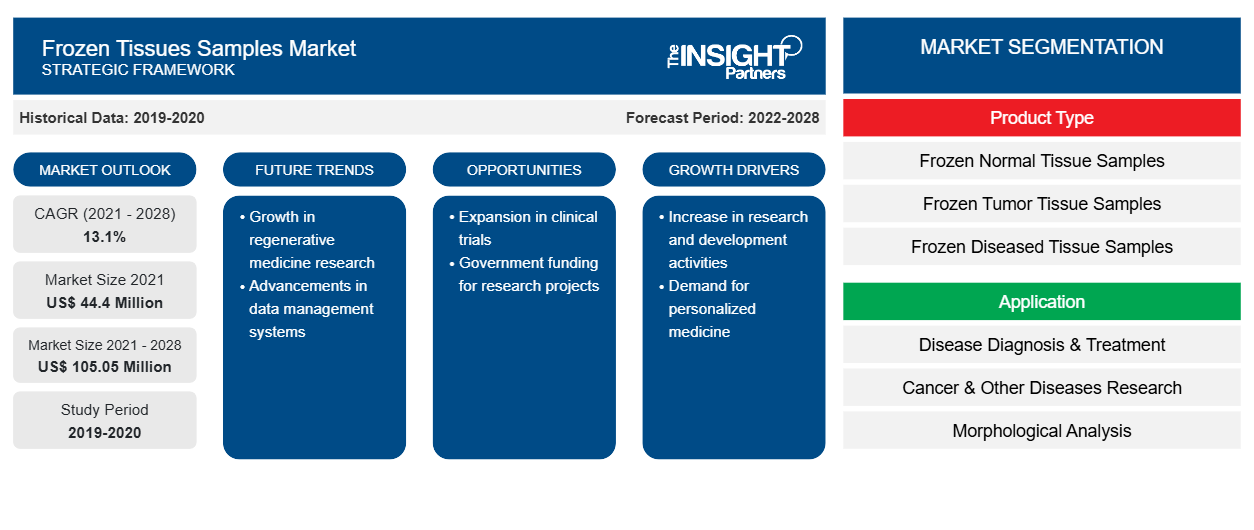Der Markt für gefrorene Gewebeproben soll von 44.399.070 US-Dollar im Jahr 2021 auf 105.045.910 US-Dollar im Jahr 2028 anwachsen. Der Markt soll im Zeitraum 2021–2028 mit einer durchschnittlichen jährlichen Wachstumsrate von 13,1 % wachsen.
Gefrorene Gewebeproben werden bevorzugt für Analysen wie Next-Generation-Sequencing , Western Blotting für posttranslationale Proteinmodifikationen, Massenspektrometrie und quantitative Echtzeit-Polymerase-Kettenreaktion verwendet. Gefrorene Gewebeproben sind der Goldstandard für die DNA- und RNA-Sequenzierung, insbesondere wenn die Stränge länger als 50 Paare sein müssen. Gefrorene Gewebeproben sind auch in der Immunhistochemie nützlich, da die Proteine noch in ihrem nativen Zustand erhalten bleiben.
Passen Sie diesen Bericht Ihren Anforderungen an
Sie erhalten kostenlose Anpassungen an jedem Bericht, einschließlich Teilen dieses Berichts oder einer Analyse auf Länderebene, eines Excel-Datenpakets sowie tolle Angebote und Rabatte für Start-ups und Universitäten.
-
Holen Sie sich die wichtigsten Markttrends aus diesem Bericht.Dieses KOSTENLOSE Beispiel umfasst eine Datenanalyse von Markttrends bis hin zu Schätzungen und Prognosen.
Das globale Marktwachstum für gefrorene Gewebeproben ist auf die zunehmende Anwendung gefrorener Gewebeproben in verschiedenen Forschungs- und Therapiebereichen und die zunehmende Verwendung gefrorener Gewebeproben aufgrund der steigenden Krebsprävalenz zurückzuführen. Das mit der Konservierung und Aufbewahrung gefrorener Gewebeproben verbundene Risiko behindert jedoch in gewissem Maße das globale Marktwachstum für gefrorene Gewebeproben.
Zunehmende Verwendung von gefrorenen Gewebeproben aufgrund steigender Krebshäufigkeit
Laut den von Cancer Research UK im Jahr 2020 veröffentlichten Daten sterben in Großbritannien jedes Jahr rund 0,16 Millionen Menschen an Krebs. Darüber hinaus hat laut dem Globocan-Bericht im Jahr 2020 Brustkrebs bei Frauen Lungenkrebs als am häufigsten diagnostizierte Krebsart überholt, mit schätzungsweise 2,3 Millionen Neuerkrankungen (11,7 %), gefolgt von Lungenkrebs (11,4 %), Dickdarmkrebs (10,0 %), Prostatakrebs (7,3 %) und Magenkrebs (5,6 %). Lungenkrebs blieb mit schätzungsweise 1,8 Millionen Todesfällen (18 %) die häufigste durch Krebs diagnostizierte Todesursache, gefolgt von Dickdarmkrebs (9,4 %), Leberkrebs (8,3 %), Magenkrebs (7,7 %) und Brustkrebs bei Frauen (6,9 %). Die Gesamtinzidenz war in Übergangsländern zwei- bis dreimal höher als in Übergangsländern. Allerdings waren die Todesfälle durch Brust- und Gebärmutterhalskrebs bei Frauen in Übergangsländern deutlich höher als in Übergangsländern. Eine so hohe Krebsprävalenz erfordert den Bedarf an gefrorenen Gewebeproben für Forschung und Studien. Die zunehmenden Studien mit gefrorenen Tumorgewebeproben bieten mehrere Diagnose- und Behandlungsmöglichkeiten für diese chronische Erkrankung. Daher treibt die weltweit steigende Krebsinzidenz das Wachstum des Marktes für gefrorene Gewebeproben voran. Darüber hinaus ist Krebs in Kanada die häufigste Todesursache in der Bevölkerung und in den USA die zweithäufigste Todesursache nach Herzerkrankungen. Laut der American Cancer Society werden in den USA im Jahr 2022 etwa 1,9 Millionen neue Krebsfälle diagnostiziert und 609.360 Todesfälle geschätzt. Prostatakrebs ist die am häufigsten diagnostizierte Krebsart bei Männern in Nordamerika; bei Frauen ist Brustkrebs jedoch nach wie vor die häufigste. Darüber hinaus bleibt Lungenkrebs die häufigste Todesursache in der Bevölkerung. Es wird geschätzt, dass die Zahl der neuen Krebsfälle 439,2 pro 100.000 Männer und Frauen pro Jahr beträgt. Daher führt die zunehmende Verbreitung von Krebs in der Bevölkerung zum Wachstum des Marktes für gefrorene Gewebeproben weltweit.
Produktbasierte Erkenntnisse
Der globale Markt für gefrorene Gewebeproben ist je nach Produkt in gefrorene normale Gewebeproben, gefrorene Tumorgewebeproben und gefrorene erkrankte Gewebeproben unterteilt. Das Segment der gefrorenen Tumorgewebeproben hatte 2021 den größten Marktanteil. Darüber hinaus wird erwartet, dass dasselbe Segment im Prognosezeitraum von 2021 bis 2028 die höchste durchschnittliche jährliche Wachstumsrate (CAGR) auf dem Markt für gefrorene Gewebeproben verzeichnet. Das Wachstum ist hauptsächlich auf die weltweit zunehmende Zahl von Tumorfällen zurückzuführen.
Anwendungsbasierte Erkenntnisse
Basierend auf der Anwendung ist der globale Markt für gefrorene Gewebeproben in Krankheitsdiagnose und -behandlung, Krebs- und andere Krankheitsforschung sowie morphologische Analyse unterteilt. Im Jahr 2021 hatte das Segment Krebs- und andere Krankheitsforschung den größten Anteil am globalen Markt für gefrorene Gewebeproben. Es wird jedoch erwartet, dass das Segment Krankheitsdiagnose und -behandlung von 2021 bis 2028 mit 13,8 % das schnellste CAGR-Wachstum verzeichnet.
Endbenutzerbasierte Erkenntnisse
Der globale Markt für gefrorene Gewebeproben ist nach Endverbrauchern in akademische und Forschungsinstitute, Krankenhäuser und Kliniken, Diagnosezentren und andere unterteilt. Im Jahr 2021 hielt das Segment der akademischen und Forschungsinstitute den größten Anteil am globalen Markt für gefrorene Gewebeproben. Es wird jedoch erwartet, dass das Segment der Krankenhäuser und Kliniken von 2021 bis 2028 mit einer durchschnittlichen jährlichen Wachstumsrate von 13,9 % am schnellsten wächst.
Produkteinführungen und -zulassungen sind häufig von Unternehmen angewandte Strategien, um ihre globale Präsenz und ihr Produktportfolio zu erweitern. Darüber hinaus konzentrieren sich die Marktteilnehmer für gefrorene Gewebeproben auf die Partnerschaftsstrategie, um ihren Kundenstamm zu vergrößern, was ihnen wiederum ermöglicht, ihren Markennamen weltweit aufrechtzuerhalten. Es wird erwartet, dass der globale Markt für gefrorene Gewebeproben mit der Entwicklung neuer innovativer Produkte durch die Marktteilnehmer florieren wird.
Regionale Einblicke in den Markt für gefrorene Gewebeproben
Die regionalen Trends und Faktoren, die den Markt für Proben gefrorenen Gewebes während des gesamten Prognosezeitraums beeinflussen, wurden von den Analysten von Insight Partners ausführlich erläutert. In diesem Abschnitt werden auch die Marktsegmente und die Geografie für Proben gefrorenen Gewebes in Nordamerika, Europa, im asiatisch-pazifischen Raum, im Nahen Osten und Afrika sowie in Süd- und Mittelamerika erörtert.

- Erhalten Sie regionale Daten zum Markt für gefrorene Gewebeproben
Umfang des Marktberichts über Proben gefrorenen Gewebes
| Berichtsattribut | Details |
|---|---|
| Marktgröße im Jahr 2021 | 44,4 Millionen US-Dollar |
| Marktgröße bis 2028 | 105,05 Millionen US-Dollar |
| Globale CAGR (2021 - 2028) | 13,1 % |
| Historische Daten | 2019-2020 |
| Prognosezeitraum | 2022–2028 |
| Abgedeckte Segmente |
Nach Produkttyp
|
| Abgedeckte Regionen und Länder |
Nordamerika
|
| Marktführer und wichtige Unternehmensprofile |
|
Dichte der Marktteilnehmer für Proben gefrorenen Gewebes: Verständnis ihrer Auswirkungen auf die Geschäftsdynamik
Der Markt für Proben gefrorener Gewebe wächst rasant, angetrieben durch die steigende Nachfrage der Endverbraucher aufgrund von Faktoren wie sich entwickelnden Verbraucherpräferenzen, technologischen Fortschritten und einem größeren Bewusstsein für die Vorteile des Produkts. Mit steigender Nachfrage erweitern Unternehmen ihr Angebot, entwickeln Innovationen, um die Bedürfnisse der Verbraucher zu erfüllen, und nutzen neue Trends, was das Marktwachstum weiter ankurbelt.
Die Marktteilnehmerdichte bezieht sich auf die Verteilung von Firmen oder Unternehmen, die in einem bestimmten Markt oder einer bestimmten Branche tätig sind. Sie gibt an, wie viele Wettbewerber (Marktteilnehmer) in einem bestimmten Marktraum im Verhältnis zu seiner Größe oder seinem gesamten Marktwert präsent sind.
Die wichtigsten auf dem Markt für gefrorene Gewebeproben tätigen Unternehmen sind:
- Audubon Bioscience Co
- REPROCELL Inc.
- Bay Biosciences LLC
- US Biolab Corporation, Inc.
- AMS Biotechnology (Europe) Ltd.
Haftungsausschluss : Die oben aufgeführten Unternehmen sind nicht in einer bestimmten Reihenfolge aufgeführt.

- Überblick über die wichtigsten Akteure auf dem Markt für gefrorene Gewebeproben
Firmenprofile
- Audubon Bioscience Co
- REPROCELL Inc.
- Bay Biosciences LLC
- US Biolab Corporation, Inc
- AMS Biotechnology (Europe) Ltd.
- Genetiker, Inc.
- ZenBio, Inc
- OriGene Technologies, Inc.
- BioChain Institute Inc
- ProteoGenex, Inc.
- Historische Analyse (2 Jahre), Basisjahr, Prognose (7 Jahre) mit CAGR
- PEST- und SWOT-Analyse
- Marktgröße Wert/Volumen – Global, Regional, Land
- Branchen- und Wettbewerbslandschaft
- Excel-Datensatz
Aktuelle Berichte
Verwandte Berichte
Erfahrungsberichte
Grund zum Kauf
- Fundierte Entscheidungsfindung
- Marktdynamik verstehen
- Wettbewerbsanalyse
- Kundeneinblicke
- Marktprognosen
- Risikominimierung
- Strategische Planung
- Investitionsbegründung
- Identifizierung neuer Märkte
- Verbesserung von Marketingstrategien
- Steigerung der Betriebseffizienz
- Anpassung an regulatorische Trends























 Kostenlose Probe anfordern für - Markt für gefrorene Gewebeproben
Kostenlose Probe anfordern für - Markt für gefrorene Gewebeproben